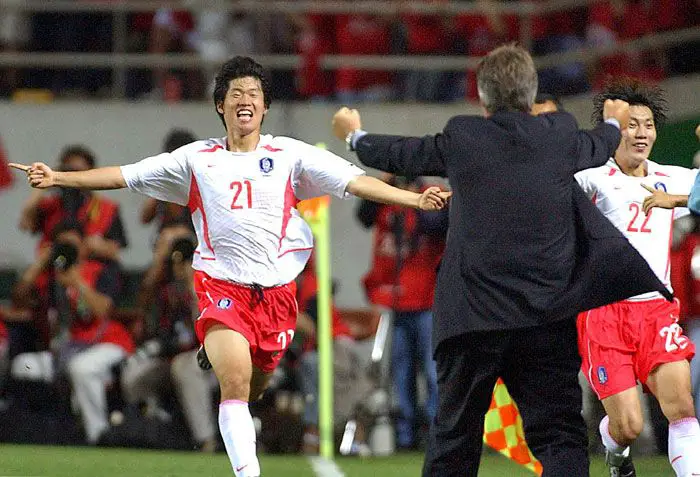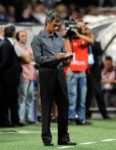This is an excerpt from the book Soccer Tactics 2014: What the World Cup taught us By Ray Power,you can buy it here.You can read the first part here and the second part here
Evolving Football Cultures
Not all countries will have a unique, pinned-down football culture or national identity. Some national teams will change their approach frequently depending on the philosophy and style of their coach. Others will dabble in various tactics and styles, trying to find their optimal way of playing the beautiful game, either because they need an evolution to take them to the next level, or a revolution to take them back to the level they expect.
South Korea
The introduction of South Korean football to the world stage began in their enthralling campaign when they co-hosted the first ever Asian World Cup in 2002. Marshalled by Dutch coach Guus Hiddink, the South Koreans won the hearts of the world with their journey to the semi-finals, before eventually being knocked out by Germany.
The one thing you expect from the South Koreans is a work-ethic and physical conditioning that reflects the honesty that people stereotypically associate with this particular Asian culture; added to which one can add a well-honed football technique. Hiddink provided a Dutch- like structure and set of tactics to this work ethic and technical ability that brought such national delight and pride to the Korean fans and media. The Dutch influence would see attractive, possession-based football brought to the fore.
The 2014 reign of coach Hong Myung-Bo saw an attempted return to this Dutch focus, following a spell under Choi Kang-Hee where a forceful direct-style was preferred. Whether purists in the Netherlands would approve of the comparison is doubtful as although midfielder Ki Sung-Yueng had completed 100% of his passes by half-time of their opening game against Russia2, the Koreans had played a number of wasteful, ill-judged longer passes, in particular to left-sided player, Son Heung-Min.
It may be more accurate to describe Myung-Bo’s efforts to mix the Dutch influence with the more direct style of his predecessor, and accommodate the quick, counter-attacking play prized in Korea, as an attempt to mix the best of all worlds. Their youthful squad however will look to build on this having exited at the group stages, and a future without the guidance of Myung-Bo.
England
Much work has gone into England’s footballing identity or “DNA” over the last decade or so. Due to the perceived lack of success at major tournaments since their only World Cup triumph at Wembley in 1966, a lot of soul-searching has been undertaken. The usual conclusions are always presented by supporters and the media following tournament exits – players are not technically good enough compared to their international rivals, youth coaching is based on brawn rather than brain, and tactically, English players simply do not understand the game well enough.
Traditionally, English teams were based around a direct-style 4-4-2 with a physically big centre- forward like Peter Crouch or Emile Heskey. Their game was about getting the ball forward quickly. This pace of play and directness can result in a lack of assured possession when asked to be patient with the ball or if asked to cut open a team who were defending resolutely. When asked to play in tight areas, the English traditionally favoured going over and around opposition bodies, rather than having the craft and guile to slice through them.
At the 2010 World Cup, the England coach Fabio Capello, tried to address difficulties around possession, and chose the smaller, more natural striker Jermain Defoe. The tactical limitations of Capello’s 4-4-2 (or 4-4-1-1) was highlighted in the tournament, particularly when trying to deal with Germany’s adventurous style and interchanging positions (something the Germans would go on to perfect in 2014).
Bizarrely, upon their win-less group-stage exit from the 2014 World Cup, the England team received arguably less criticism than they did when they were eliminated from the latter stages of previous tournaments against footballing powerhouses like Brazil and Germany. There was recognition that, although short-term gains were few, the long-term evolution of the team’s style of play was moving in the right direction.
Head coach, Roy Hodgson, chose to field a 4-2-3-1 formation, largely based around players from Liverpool who had recently excelled playing a very brave, possession-based style – although it was never in Hodgson’s own DNA to be as flamboyant as Liverpool boss Brendan Rodgers. As well as experienced international players like Steven Gerrard and Wayne Rooney, the English line-up had been freshened up with the inclusion of young, quick, exciting and almost unknown quantities like Adam Lallana (although 26 years old), Raheem Sterling and Daniel Sturridge – with others like Ross Barkley, Alex Oxlade-Chamberlain and Luke Shaw waiting in the wings (with Shaw’s appearance in the final group game against Costa Rica, he became the youngest participant at the 2014 World Cup, at 18 years of age). In fact, 12 of their World Cup squad had less than 15 caps at the beginning of the tournament. There is a sense that England, in coming tournaments, may evolve and revolve around these gifted technicians, rather than around the big, powerful target strikers.












Recent Comments